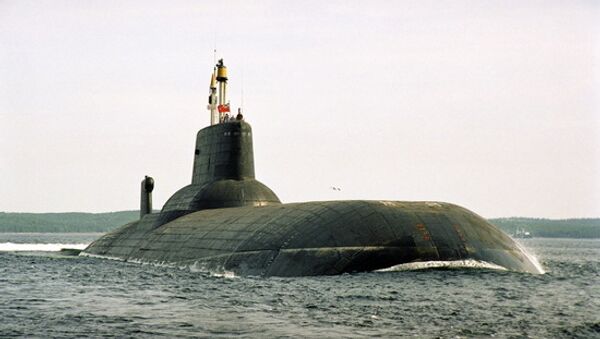On September 23 1980, a cutting edge Soviet nuclear ballistic missile submarine set out from the Severodvinsk shipyards. The lead vessel of the Soviet third generation Project 941 Akula class (NATO reporting name Typhoon) of ballistic missile submarines, better known to readers by its nickname, the Dmitry Donskoy, was unique in many ways. It was designed as the world's largest submarine, and its displacement of nearly 50,000 metric tons put it in the same class as battleships and aircraft carriers, the largest warships ever.
This Dmitry Donskoy and her five sister submarines were unique to be sure, but they were also bona fide white elephants - a common name for vessels that are more trouble than they're worth.
Offspring of the arms race
The new missile carrier was designed amid yet another escalation of the arms race. Work began in 1972, when the United States announced the creation of its next-generation Ohio class submarines, equipped with Trident I C4 missiles and launching systems.
The Soviet missile carrier was expected to outmatch the new U.S. submarine in all key features. However, this was easier said than done. The missile was the main problem. The Soviet Navy, which already had experience with liquid fuel ballistic missiles, insisted that the new missile had to be powered by solid fuel like American missiles launched from submarines, as they were easier to make and safer to store and use.
However, building the new missile proved challenging for the Soviets, who lagged far behind the United States in solid fuel technology. The new Soviet missile, R-39, was much larger than the Trident I and three times as heavy, 90 tons against 32.3 tons.
That was the first step on the path to building the world's largest ballistic missile submarine. The second step was made after a study was made of the vessel's stationing and service role. The Rubin design bureau, which designed the submarine, was asked to increase its buoyancy to achieve minimal draft, so that the new submarine could use the existing piers and docks; additional buoyancy would also help it operate better in ice-covered waters.
The lead ship vessel was laid on March 16, 1976 and completed in a very short period of time, considering its size. However, its weapons, the R-39 missiles were not ready by its launch in September 1980 or even by its commissioning date in December 1981.
Testing of the R-39 began in 1977, and work was progressing unusually slowly. Half of the 17 launches from a submerged test stand or a submarine failed. As a result, the D-19 system and its new missiles were not ready until 1984, when it was finally incorporated into the Navy.
Strengths and weaknesses
A total of six ballistic missile submarines were laid between 1976 and 1985 under the new project. They were commissioned from 1981 through 1989. A seventh submarine was planned but never built. The project's strengths and weaknesses were apparent by that time. The submarine's high endurance was certainly an advantage, and so was the comfort afforded to the crew by the vessel's massive size.
However, its size was also a weakness. First of all, propelling the massive vessel required a very powerful engine, which made the submarine noisier. The project also exacted a heavy toll on the Soviet economy. These unique submarines, unmatched in the world, were also several times more expensive than the 667BDRM Delfin submarines built in the early 1980s. While they had less fire power - 16 missiles and 64 warheads against 20 and 200 - the Delfins proved more economically efficient per warhead delivery.
The short-lived giants
Akula submarines did not have a long career. This entire class submarines were decommissioned in 1995-2005 after the service lives of their R-39 missiles expired and could not be extended. The submarines could have been given a new lease on life if they had been equipped with newer weapons. However, the new missile, the R-39UTTH Bark (NATO reporting name SS-N-28), was designed for the Project 935 submarines and later for the Project 955 fourth-generation submarines, the Borei.
The Russian Navy lacked the funds to modernize the Akulas, and it focused on preserving active 667BDRM and 667BDR submarines instead.
The Bark project was abandoned soon after and replaced by the Bulava, a far smaller and lighter missile.
However, the lead vessel of Project 941, named Dmitry Donskoy after the Grand Duke of Moscow (1359-1389), was upgraded to launch Bulava missiles, and all 12 Bulava launches were made from that submarine. In addition to the Dmitry Donskoy, two more submarines are kept as back up in Severodvinsk, TK-17 Arkhangelsk and TK-20 Severstal. These can also be upgraded to launch Bulavas, if their final tests are successful.
However, many experts believe this project is inefficient. The old drawbacks of the Akula class have not been addressed, so it would be wiser to modernize the Delfins, which have been showing better results throughout. The Delfins are equipped with new liquid-fuel R-29RM Sineva missiles, considered the top in their class.
Akulas are not likely to be retooled as transport submarines for year-round use on the Northern Sea Route either, as there is no clear economic rationale for such a project.
At any rate, Akulas will be remembered as unique vessels born of the technological and operational limitations of the time. The attempt to overcome these limitations resulted in exorbitant costs and a fleet of white elephants.
Ilya Kramnik, RIA Novosti military commentator
The opinions expressed in this article are the author's and do not necessarily represent those of RIA Novosti.



